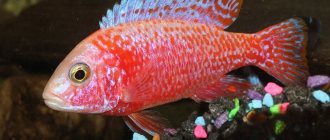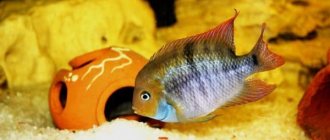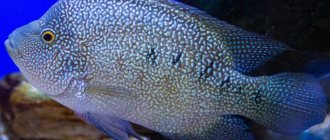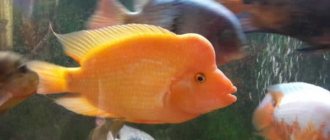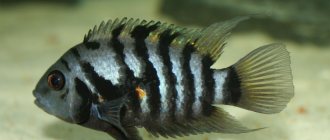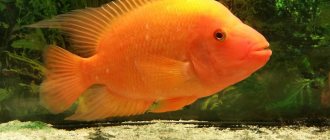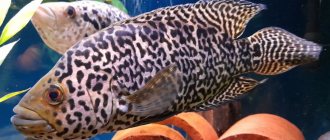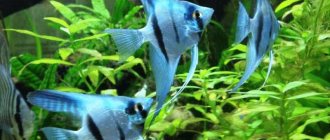The Nicaraguan cichlid is an aquarium fish that pleases aquarists with its bright appearance and non-aggressive character. However, it is not very common among breeders, and therefore is considered a rather rare inhabitant of home tanks. Beginning aquarists should take a closer look at it, if only because the fish does not require special attention.
Description
The distinctive external characteristics of the presented cichlid are:
- stocky body, reaching 25 cm in length;
- curved head;
- mouth located at the bottom of the head;
- golden-copper body and greenish-blue head;
- the presence of many dark spots on the fins;
- red edging on caudal fin.
When wondering how long these individuals live, it is worth looking at their description. The average life expectancy is 10-15 years.
Nutrition of Nicaraguan cichlazoma
In natural conditions, the plant food base predominates, but in an aquarium they will eat any live and frozen food with great appetite, starting with bloodworms and ending with coretra and plankton. It is necessary to provide plant food - this will help the fish get all the necessary microelements. Zucchini or finely chopped cucumber will become a real treat for your pets.
These fish also eat animal food well – pieces of fish, lean meat. However, you should know when to stop – these foods are poorly digestible and can cause various digestive problems.
Maintenance and care
To ensure that the maintenance and care of fish do not require special attention, it is important initially, when arranging its home, to observe certain water parameters:
- temperature - from 25°C to 28°C;
- hardness (dH) - from 8° to 15°;
- acidity (pH) - from 6.5° to 7.5°.
Lighting in the tank should be moderate. Fish need clean air, and therefore it is necessary to install aeration and filtration systems. It is a known fact that individuals will be more comfortable in conditions close to natural. For this reason, it is better to give preference to soft sandy soil or substrate. Plants should first be planted in small pots and only then placed in the aquarium. Otherwise, individuals will “dig up” them by the roots.
A quarter of the water in the tank needs to be changed weekly. In addition, it would be useful to purchase a siphon, which can be used to clean the soil from fish excrement and food debris. As for the capacity of the tank, a couple of individuals should have at least one hundred liters of water. By creating the described conditions, you can achieve maximum life expectancy for fish at home.
Behavior and Compatibility
The Nicaraguan cichlid, like other representatives of this subspecies, protects its territory, and therefore can be aggressive towards other aquarium inhabitants, especially if there is insufficient free space in an artificial reservoir. These fish lead a paired lifestyle. But they can be kept together with other cichlids.
Experts advise breeding at least 6-7 individuals in the same age category at once, which will reduce the level of possible aggression and avoid conflict situations.
Many aquarists note the quite successful association of the Nicaraguan cichlid with other species of aquarium fish, of the same size or slightly larger.
It is definitely contraindicated to keep cichlases together with small fish, since due to the natural hunting instincts of the former, they will be perceived as potential prey.
Features of behavior
Breeders, of whom there are few, note that the described cichlazomas are paired creatures. That is, at the beginning of their life's journey they create a couple with whom they remain throughout their lives. In principle, individuals are distinguished by peaceful behavior, however, they can fight with other inhabitants of the aquarium for territory.
To create optimal conditions for these representatives of the Cichlid family to live together, it is important not to overpopulate the tank, introduce fish at the same time, and make sure that they are of the same age. It is worth making sure that the individuals have enough shelters where they can hide from other inhabitants of the aquarium.
Breeding
Nicaraguan cichlisoma successfully reproduces in an aquarium. They lay their eggs in holes, but should be considered monogamous pairs that need plenty of caves and hiding places.
They dig a hole in the shelter, since Nicaraguan caviar is not sticky and they cannot attach it to the walls of the shelter.
The female lays eggs, which are transparent and quite large (2 mm). At a temperature of 26° C, it hatches on the third day, and after another 4-5 days, the fry will swim.
From now on, it can be fed with Artemia nauplii. The parents always look after the eggs and fry; more precisely, the female looks after her, and the male protects her.
Feeding
In natural conditions, as well as in domestic conditions, the described cichlid is omnivorous. It can be fed dry as well as live food. The best options in the latter case are bloodworms, brine shrimp, tubifex, and coretra.
Do not forget that the diet of fish should be as balanced as possible. Therefore, it is important to remember about the use of fertilizers. In this case, the best options are spirulina tablets, cucumbers, zucchini, spinach and lettuce leaves.
It is important not to overfeed the fish. This means that one feeding per day is enough for them to receive maximum vital energy. It is worth removing the remains of food that has not been used by individuals, as it will decompose and pollute their habitat.
How and what to feed
Nicaraguan cichlid is unpretentious in terms of nutrition and is considered an omnivorous species. In their natural habitat, these fish feed mainly on invertebrates, algae, snails, and leafy platinum of various underwater and surface crops. When kept in an aquarium, they happily consume both dry and frozen food.
But to maintain health and increase the life expectancy of the Nicaraguan cichlid, it is recommended to include live food in the form of bloodworms, worms, and brine shrimp in its menu. These fish, unlike most other aquarium inhabitants, have a high need for plant food. Therefore, their diet must certainly include spirulina, chopped greens and lettuce. Representatives of this species will also appreciate fresh, pre-chopped cucumbers, zucchini, and radishes.
Cichlids also love natural meat, but they are allowed to offer it only occasionally and in minimal quantities in order to avoid the development of obesity and metabolic disorders.
Sex differences
Inexperienced aquarists are interested in the question of how to determine the sex of purchased specimens. When they are young, this is almost impossible to do, and therefore breeders recommend introducing 6-8 fish into the tank, from which pairs will subsequently form.
Adults have pronounced sexual differences. Distinctive features of males are:
- large, fleshy body equipped with a pointed dorsal fin;
- the presence of black specks on the fins;
- massive lump in the frontal region;
- not too bright body color;
- the presence of a cone-shaped vas deferens near the anal fin during spawning.
The distinctive features of females are:
- bright color;
- slender body;
- rounded dorsal fin;
- presence of a trapezoidal ovipositor.
Compatibility with other fish
Like all cichlids, the Nicaraguan is territorial and aggressive when defending its territory. However, she is less aggressive than other cichlids of her size.
It can be kept with other cichlids - bee, blackstripe, meeka, salvini. They keep in pairs, which is easiest to choose if you buy 6-8 young fish and raise them together, giving them time to decide on a pair for themselves.
Reproduction and breeding
Taking into account the fact that the male and female choose each other once and for life, it is better if spawning takes place in a separate aquarium specially equipped for this. Its capacity must be at least 60 liters. Fine gravel is suitable as a substrate, where the female will dig a hole for laying eggs.
After the male fertilizes the eggs, the female takes care of them, carefully sorting them out. The incubation period is known to range from two to four days. The larvae with a yolk sac appear first. Five days after this, the fry appear and must be fed with starter feed.
The “parents” are kept with the young until the babies reach a diameter of 1 cm. Then the mature individuals are moved into a common aquarium. If this is not done in time, cichlids may eat their own offspring. The fish will be ready for reproduction and breeding at the age of 8-9 months.
Content
To keep a couple of fish you need an aquarium of at least 300 liters, and the larger it is, the better. They love currents and clean water, so you need to use a powerful external filter.
Since quite a lot of waste remains after feeding, you need to change about 20% of the water weekly and be sure to siphon the bottom.
In the aquarium, it is worth creating a biotope reminiscent of a river in Central America: a sandy bottom, many shelters among stones and snags.
Since the Nicaraguan one really likes to dig in the soil, it makes sense to keep plants only in pots and hard-leaved species. They can also tear off and eat young leaves, especially during spawning.
Diseases, their prevention
Nicaraguan cichlisoma is characterized by good health. Most often, she is diagnosed with diseases such as:
- obesity;
- dystrophy of internal organs;
- exhaustion of the body.
The best prevention of such conditions is a properly selected diet and maintaining cleanliness in the aquarium. It is important to protect your fish from stressful situations.
You should not pay attention to the fact that the described species of cichlids is not considered one of the most popular. What is more important is that proper care and maintenance will make them the best decoration for the home of even a novice aquarist.
Appearance
The Nicaraguan cichlid belongs to the cichlid family. The historical homeland of this fish is Costa Rica and Nicaragua. This is the most striking and spectacular cichlid in appearance. Surprisingly, it is not particularly popular among beginner aquarists.
This is explained by the fact that young individuals really look rather modest and inconspicuous, not attracting attention with their brownish color. However, specialists and experienced aquarists know very well that after some time the Nicaraguan cichlisoma acquires stunning, incredibly bright and spectacular colors.
The body of cichlazoma has a unique golden-diamond hue, shimmering with all the colors of the rainbow, the abdomen is painted in a rich scarlet color, and the gills and head are bright blue. However, there are other color options, although the one described above is considered the most common among fish raised in an artificial environment.
The Nicaraguan cichlid has a rather strong build and large size. The size of an adult is about 25 cm. The body structure of the fish is also unusual. The body itself is compact and slightly flattened, and the head is bizarrely curved. A large mouth with puffy lips and huge bulging eyes are also characteristic features of the appearance of this cichlid species. Males differ from females in their more impressive size and bright, rich color.
Origin
The Nicaraguan cichlid was described by Gunther in 1864. Found in Central America along the Atlantic slope. Found in the San Juan drainage, Lake Nicaragua, and the Matina River in Costa Rica. This species crosses with the black-striped cichlid (Amatitlania nigrofasciata), and the offspring are fertile until at least the 4th generation.
Nicaraguan cichlids are found in lakes and slow-moving rivers. Juveniles and juveniles will feed on aquatic insects, while adult fish feed on bottom detritus, seeds and leaves, snails and other molluscs.
Care of juveniles
“Live dust” is used as a starter feed. It is best to prepare it before spawning in order to satisfy the fry’s need for nutritious food in time. To prepare it, a culture of ciliates is taken and diluted in a jar. A few drops of milk and a dried banana peel are used to feed the colony, and the jar itself should be covered with a lid and kept in a dark and warm place.
In addition to “live dust”, fry can be given:
- small daphnia;
- Artemia nauplii;
- Cyclops;
- grated boiled yolk.
As they grow older, larger foods are added to the diet of the juveniles.
All this time, the parents protect the offspring, help them eat, lifting mud from the bottom and biting into large food for them. But as soon as the juveniles reach a size of about 1 cm, it is better to remove the breeders, because their parental instinct disappears, and they will not mind snacking on their brood.
In order for the fry to grow healthy, the nursery aquarium must be kept clean. It is necessary to remove dead fry and leftover food in a timely manner, otherwise they may decompose and spoil the water. It is advisable to grade the brood, removing fish that are lagging in growth and providing them with intensive nutrition.

